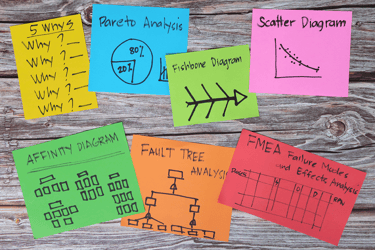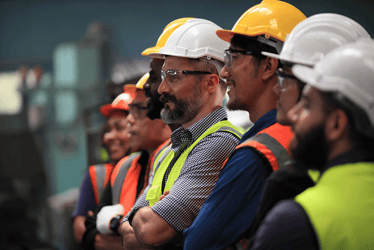The Packaging Industry's Sustainability Challenge: Why ERP Systems Are Essential for Success A straightforward guide to navigating sustainability regulations across folding carton, flexible...
The power of plant floor data collection: a deep dive into corrugated digital transformation
In a time of rapid technological progress and evolving markets, the corrugated manufacturing industry is on the cusp of a significant transformation.
This article delves into how integrating advanced data collection technologies on the plant floor can revolutionize efficiency, sustainability, and competitiveness.
We explore the power of real-time data to shift from traditional to proactive, insight-driven operations. Highlighting the strategic importance of a data-driven approach, the article examines its broad impacts, including improved sustainability, competitive edges, and the need for a data-literate culture. It outlines the path for corrugated manufacturers to seize digital transformation's full benefits, paving the way for operational excellence and leadership in the digital era.
The corrugated manufacturing sector is poised for a monumental shift driven by technology's relentless march and the global market's ever-changing demands. At the core of this transformation is the integration of advanced plant floor data collection technologies, a strategic pivot that promises to redefine the industry's benchmarks of efficiency, sustainability, and competitive edge.
The impetus for this shift is twofold: the relentless pursuit of operational excellence and the imperative to adapt to a market that values agility, quality, and environmental stewardship. By embracing a data-driven manufacturing paradigm, corrugated manufacturers unlock new realms of insight and efficiency, transitioning from traditional reactive models to proactive, insight-driven processes. This transition is not merely about adopting new technologies; it's about reimagining the essence of manufacturing operations - how they're conducted, analyzed, and optimized for a digital age.
Integrating sensors for data collection
Integrating sensors, IoT devices, and sophisticated analytics platforms on the manufacturing floor enables unprecedented data collection and analysis. This deep, granular view into every aspect of production processes - from the performance of individual machines to the efficiency of entire production lines - illuminates areas previously hidden by the opacity of manual data collection methods. The benefits of this transition extend well beyond the factory floor, influencing sustainability practices, enhancing competitive capabilities, and reshaping strategic decision-making processes.
Data-driven sustainability
Sustainability, in particular, emerges as a significant beneficiary of this technological evolution. By leveraging real-time data, manufacturers can optimize resource use, minimize waste, and improve energy efficiency with previously unattainable precision. This aligns with the growing global emphasis on environmental responsibility and positions manufacturers to meet the demands of an increasingly eco-conscious consumer base. The commitment to sustainability, facilitated by advanced data collection, becomes a powerful differentiator in the market, opening new avenues for growth and customer engagement.
Furthermore, a data-driven manufacturing approach confers transformative competitive advantages. In an industry characterized by thin margins and exacting customer expectations, manufacturers can stand out by being agile, responding swiftly to market changes, streamlining operations, and reducing costs. The insights derived from comprehensive plant floor data collection enable a level of responsiveness and innovation paramount for sustaining and enhancing market leadership in the corrugated industry.
Transitioning to this new paradigm, however, presents a multifaceted challenge. It necessitates the technical integration of advanced data collection technologies and a significant cultural shift within the organization. Realizing these technologies' full potential involves cultivating a data-centric organizational culture, enhancing employee data literacy, and aligning technological initiatives with strategic business objectives. This holistic approach ensures that the technological transformation transcends mere operational upgrades, fostering a culture of continuous innovation and strategic agility.
As the global tapestry of corrugated manufacturing evolves, marked by diverse regional practices and challenges, the pursuit of operational optimization remains a unifying theme. This quest transcends traditional objectives, focusing instead on achieving a strategic balance between efficiency, quality, and sustainability. Adopting data analytics, IoT technologies, and sustainable materials demonstrate a sector-wide commitment to enhancing operational performance, delivering superior value to customers, and minimizing environmental impact. The drive for optimization, deeply integrated with data-driven insights, positions the corrugated industry at the vanguard of industrial innovation and sustainability.
Operational efficiency and Industry 4.0
Operational efficiency, the cornerstone of manufacturing excellence, undergoes a radical transformation in this new data-driven landscape. The shift toward automated data collection and analysis technologies, leveraging the power of IoT, AI, and machine learning, departs from the limitations of traditional methodologies. This evolution enhances resource utilization and waste reduction and embodies a broader commitment to innovation, efficiency, and sustainability within the industry.
The integration of Industry 4.0 technologies heralds a new era of interconnected and intelligent manufacturing. Manufacturers gain a detailed understanding of their production processes through the strategic application of IoT sensors and advanced analytics, enabling unprecedented levels of quality control, supply chain efficiency, and customer satisfaction. This technological integration fosters a more adaptable, efficient, and customer-focused manufacturing ecosystem, setting new standards for excellence in the corrugated industry.
Sustainability, once a peripheral consideration, now occupies a central role in manufacturing strategy, driven by the capabilities of advanced data collection technologies. These tools provide the insights necessary for precise monitoring and optimization of environmental performance, aligning operational practices with the broader goals of environmental stewardship and regulatory compliance. The strategic value of sustainability, amplified by data-driven insights, propels manufacturers toward more efficient, responsible, and competitive operations.
Artificial intelligence (AI)
Introducing artificial intelligence (AI) into the manufacturing process marks a significant evolution. AI technologies automate decision-making, enhance predictive analytics, and optimize production schedules. This integration represents an operational upgrade and a fundamental reimagining of manufacturing efficiency, quality, and innovation. The journey toward AI-driven manufacturing promises a future of operational excellence characterized by seamless efficiency, reduced waste, and enhanced decision-making capabilities.
Implementing data collection for digital transformation
Implementing advanced data collection technologies entails navigating complex challenges, from understanding existing production workflows to fostering a culture of innovation and digital fluency across the organization. The initial step in this journey involves a deep dive into the current state of production processes, identifying how and where advanced data collection technologies can be most effectively integrated to enhance visibility and drive efficiencies. Developing a clear, strategic roadmap for digital transformation is crucial, outlining the technological integration and the anticipated impacts on process improvements, cost efficiencies, and product quality. This strategy must align with the broader business objectives, ensuring that the technological enhancements propel the organization toward its competitive and operational goals.
The human element plays a pivotal role in this transformation. The successful integration of advanced data collection technologies hinges on the workforce's ability to adapt to and leverage these new tools. Investing in training and development is paramount, as well as ensuring employees are proficient in the technical aspects of these technologies and understand their strategic importance to the organization. Cultivating a data-driven culture necessitates a shift in mindset at all levels of the organization, where data literacy becomes a fundamental competency. Leadership must champion this shift, modelling data-driven decision-making and fostering an environment where experimentation and innovation are encouraged.
The challenges associated with implementing these technologies are significant, yet the potential benefits outweigh them. Overcoming these hurdles requires a collaborative, inclusive approach, engaging stakeholders across the organization to ensure a seamless transition. This collaborative spirit ensures that technological initiatives are grounded in the practical realities of the production environment and aligned with organizational objectives. By embracing these challenges as opportunities for growth, organizations can unlock the full potential of advanced data collection technologies, transform their operations, and secure a competitive advantage in the evolving manufacturing landscape.
A culture of data literacy for continuous improvement
Building a culture of data literacy is integral to this transformation. Beyond technical proficiency, data literacy encompasses an intuitive understanding of how data can inform decision-making, drive process improvements, and foster innovation. This cultural shift involves creating an environment where data is not just accessible but is actively used to guide strategic and operational decisions. Continuous education and training initiatives, leadership engagement, and a commitment to innovation are crucial to embedding data literacy into the organizational DNA.
The strategic imperative for continuous innovation underpins the entire transformation journey. In a market characterized by rapid changes and intense competition, corrugated manufacturers must leverage advanced data collection and analysis technologies to enhance operational efficiency, drive sustainable practices, and meet evolving customer expectations. This commitment to innovation will differentiate corrugated industry leaders and ensure long-term success and relevance in a digital-first marketplace.
Conclusion
As the corrugated industry navigates this period of significant change, the strategic integration of advanced plant floor data collection technologies emerges as a cornerstone for future success. This shift towards a data-driven manufacturing model promises to enhance operational efficiency and sustainability and redefine competitive dynamics within the industry.
Embracing these technologies and the requisite cultural and strategic shifts positions corrugated manufacturers to thrive in the digital age. The journey is complex and challenging, but the rewards - operational excellence, environmental stewardship, and market leadership - are profound. As the industry continues to evolve, the strategic embrace of technological advancements and the commitment to continuous innovation will be pivotal in shaping the future of corrugated manufacturing.



